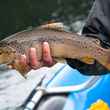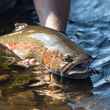For most Americans fish don’t count as wildlife. They’re slimy, cold, featherless, furless, silent and, save for anglers, generally unseen.
In my last Hatch Magazine article, "A Plague on All Your Trout," I quoted Wilderness Watch, which passionately defends icons of wilderness like grizzlies and wolves but dismisses icons of wilderness like Gila trout. I don’t mean to pick on this group because it does some good in its own way. But its condemnation of Gila trout recovery, mandated by the Endangered Species Act, provides the best example I’ve seen of how much of the public and environmental community perceive fish: “It is both sad and ironic that it was Aldo Leopold who convinced the Forest Service to protect the Gila [National Forest] as our nation's first wilderness in the 1930s — now, it is in danger of being converted to a fish farm for recreationists.”
I wasn’t lusting for 7-inch trout in 1994 when I flew from Boston to Albuquerque, trekked into the Gila Wilderness and waded up Black Canyon Creek. This recreationist didn’t even tote a rod.
Kit Laney’s trespassing cattle waded ahead of me, defecating and urinating into the stream. In the bigger, sunlit pools, old cow pies had blossomed into gobs of green algae. Hovering under these gobs were rainbow/Gila hybrids. Pure rainbows would have died in the warm, recently deoxygenated water. But Gilas are a desert fish, and Gila genes protected the mongrels.
Egged on and funded by property-rights groups, Laney consistently ignored Forest Service citations and permit cancellations. There was prolonged litigation, all won by the feds. Finally the Forest Service seized Laney’s trespassing cattle and sold them at public auction. For assaulting law-enforcement officers during the roundup, Laney was jailed for six months.

When Black Canyon Creek healed the U.S. Fish and Wildlife Service and New Mexico Department of Game and Fish eradicated the hybrids. Rotenone or Antimycin (an even shorter-lived organic piscicide then available) could have reclaimed the stream in a day. But Wilderness Watch and its allies had prevailed on the county to ban both. So the job took a 20-man team equipped with backpack electro-shockers 88 days.
Then, as the agencies prepared to reintroduce pure Gilas, alien rainbows, browns and cutthroats showed up. Anglers had sabotaged the project. After hybrids had been eradicated from another Gila trout stream, it too was sabotaged.
The saboteurs hurt themselves. With home-court advantage, Gila trout grow bigger and faster than nonnative, coldwater salmonids. Today, with Gilas downlisted from endangered to threatened, there’s abundant fishing opportunity. Recovery continues.
So what of the “recreationists” mentioned by Wilderness Watch? Many share its perception that fish are somehow detached from earth’s biota. Provided fish bend rods, it matters not if they are native, alien or mongrels. In fact, mongrels are often preferred because of hybrid vigor.
Take this complaint from one reader, Robert,: “Re. Ted Williams’ attack on ‘mongrel trout’ in High Country News: Most Americans believe there is nothing wrong with human genetic mixing! I am a mongrel of sorts myself and delight in my diversity. Many humans naturally find attractive members of different races and ethnic makeup. We Americans champion the freedom to love whoever we choose to love ... We abhor those who seek human genetic purity! American military men and women have died and continue to die for the freedom of others oppressed by those who wish to impose the same limitations on man as you are seeking to impose on trout. One could argue that what you champion is an environmental form of ‘ethnic cleansing’ or the Nazi equivalent of racial purity. ‘Purity,’ I am uncomfortable with that word! ‘Purity’ is a word often used by racists, Nazis and bigots. ‘Purity,’ that word is very much part of the argument to restore the Paiute cutthroat trout.”
I responded, “Dear Robert, genetic swamping by alien rainbow trout threatens to excise our rarest and most endangered salmonid, the Paiute cutthroat, from the planet. Unless your progenitors have successfully bred with, say, chimpanzees, the ‘genetic diversity’ you delight in does not include this kind of inter-species hybridization.”
The Native Fish Coalition (NFC), for which I serve as National Chair, is constantly scolded by anglers like Robert who imagine that we hate all nonnative fish and desire to cleanse their genes from the continent. We do our best to explain that we desire nothing of the sort, that removing alien genes is only possible in tiny headwaters and small impoundments and that there’s usually no reason to remove them anyway.
For instance, in my state of Massachusetts — in fact, in most states — no lake is capable of sustaining reproducing trout, native or otherwise. And virtually all standing water is populated with alien fish that do little or no damage to natives. Yet many anglers believe that resource agencies and native-fish advocates are bent on and capable of wiping out alien fish, especially brown trout, in every waterbody from Arkansas’ White River to Lake Ontario.
I don’t know one NFC member or staffer who doesn’t love to fish for brown trout and other nonnative trout where they’re the only game in town. We just don’t promote them. We don’t even promote fishing. We’re strictly about natives -- everything from tuna to darters with no preference.
Managers — not fisheries biologists but the bureaucrats who call the shots — also view fish as detached from earth’s biota. If you doubt this, consider Frankenfish, mutants and genetic cocktails whipped up in hatcheries for no purpose other than amusing and attracting ecologically challenged license buyers.
Maybe the most obscene example is the “golden rainbow,” aka “palomino trout” mass-produced across the U.S. In 1955 a mutant, pigment-bereft female rainbow (not an albino) turned up in a West Virginia hatchery. Her banana-hued flanks so impressed hatchery technicians that they reared her in a separate tank, fertilizing her eggs with milt from normal males and selecting the blondest fry. Eight years later the supply of golden rainbows was sufficient for stocking and, soon thereafter, for distributing to all the states that clamored for them. Despite West Virginia’s 500 miles of native brook trout stream, it’s the golden rainbow that adorns the Wildlife Division’s logo.
“Everybody likes golden rainbows because they’re such an unusual fish,” proclaims Brian Wisner, hatchery director for the Pennsylvania Fish and Boat Commission. “Everybody” would include herons, cormorants, ospreys, eagles and otters which quickly pick off golden rainbows because they show up like neon lights.
“They look like a cross between rainbow trout and gold, making it a super fish,” gushes the “Outdoor Passion” (TV) team, which devoted a program to the pursuit of these mutants in Quebec. “They are so visible near the surface it’s almost sight fishing.”

The Massachusetts Division of Fisheries and Wildlife has come light years since I worked for it in the 1970s. But, like so many state game and fish agencies, it crosses brown trout and brook trout to concoct sterile “tiger trout,” genetic cocktails not just of species but genera. The Division concludes, probably accurately, that license buyers bored of pure rainbows, browns and brook trout from its hatcheries. And in case anyone likes to pretend that hatchery trout are products of nature, the Division sticks some with tags that can be exchanged for such prizes as tackle boxes.
“Splake,” highly predacious, man made crosses of brook trout and lake trout, wrongly claimed to be “sterile,” are nuking native fish across the U.S. In Maine, for example, they now infest some of the best brook trout rivers including the Rapid, Magalloway, Dead, Kennebec, Seboeis and Penobscot. The Maine Department of Inland Fisheries and Wildlife (IF&W) explains that because splake are easier to catch they provide “a better return on the sportsman’s dollar.”
Some anglers have trouble with the notion that creating easily caught fish should be a management objective. NFC’s executive director Bob Mallard, for instance, defines splake as “the hair in a hundred-dollar meal.” The Sportsman’s Alliance of Maine heartily agrees.
IF&W says it has no evidence that splake are capable of reproduction — an easy and truthful assertion where no one looks. In the Great Lakes region, splake not only reproduce but transfer their warped genes to two natives — lake trout and an imperiled race of giant brook trout called “coasters.” One sample of 15 alleged splake from Lake Superior revealed two splake/coaster hybrids, two splake/lake trout hybrids and one offspring of splake and splake.
Google “golden rainbows,” “tiger trout” and “splake,” ignore everything with my byline, and all you’ll find are effusions about how “beautiful” they are.
“We have to make up our minds,” declares Kurt Beardslee, director of the Duvall, Washington-based Wild Fish Conservancy. “Do we want a circus environment with bizarre creatures to amuse us? Or do we want to restore healthy ecosystems?”
Then there are triploids — fish concocted with three sets of chromosomes (instead of two in normal diploids) by shocking their eggs, usually with heat. Because triploids don’t divert energy to reproductive organs they grow to enormous size, rendering them popular with anglers.
Unlike most Frankenfish, triploids have a legitimate management function. Their sterility makes them relatively safe to superimpose on native populations where diploids would pollute gene pools. For example, Idaho stocked triploid rainbows to placate anglers caterwauling about Yellowstone cutthroat recovery because, as one prominent guide put it, “cutthroats are stupid and fight like slugs.”
Phil Mackey, co-owner of Mt. Lassen Trout Farms, a triploid factory in Red Bluff, California, declined to answer most of my questions because he was disgusted with the media. A Los Angeles Times editor had ruined “a really in-depth article” about his product by hatching the title “Freakoid Fish.” In other words, the editor got it right.
An outfit called “Santa Ana River Lakes and Corona Lake” in Anaheim, California stocks triploid rainbows that weigh as much as 30 pounds and sells overnight triploid fishing for $95 per family. If you haven’t just eaten, check out the photos.
Triploids even count as world records. Shortly before he died in 2013 my friend and editor John Merwin wrote this in Field & Stream: “The next giant largemouth bass or rainbow trout we hear about may well deserve an even bigger asterisk than Barry Bonds’ home-run record ... Caught in the middle is the International Game Fish Association, the slow-to-change organization that has been certifying record catches since the 1930s.” Merwin’s words were prophetic. The current IGFA world record rainbow trout is a 48-pound triploid that escaped from a fish farm on Saskatchewan’s Lake Diefenbaker.

“The social impacts of triploidy scare the heck out of me,” Tom Weseloh told me when he was directing California Trout’s Northcoast Program. “I worry about the public buying into it to the point where it doesn’t care about wild fish. And I worry about the privatization of fisheries where people can go catch 15-pound trout in a pond. Why aren’t we teaching people to be happy with a native trout that is only supposed to be 15 inches instead of 15 pounds? I don’t know how we get that message out. The [California Fish and Wildlife] Department seems only to care about size. Part of it may be a marketing issue, but I don’t think everyone in the world wants to catch huge mutant slugs.”
“Abraham knew exactly what the land was for: it was to drip milk and honey into Abraham’s mouth,” wrote Aldo Leopold in his essay The Land Ethic. We’ve come far since Biblical times, but Abraham’s perception of the purpose and function of fish hasn’t perished from our society.
For example, Californians were undone by a 2008 court order forcing the state to cease aerial bombardment of trout fingerlings onto some 175 lakes and streams in the high Sierra where trout don’t belong and where they’re chowing down on critically endangered yellow-legged frogs that didn’t evolve with them.
The general angling public wasn’t aware or didn’t care that this stocking had been a gross violation of the Endangered Species Act. A piece by San Francisco Chronicle outdoor columnist, Tom Stienstra entitled “Trout Plants Halted — It’s a Load of Bullfrogs!” elicited the following comments: “If these ‘environmentalists’ really wanted to help the poor animals, they would commit suicide …” “I strongly urge all fisherpersons to catch frogs and eat them …” “What's next? Are they going to outlaw walking along the shoreline to prevent us from stepping on the frogs?!” “Let’s deport all the environmentalists, since they’re not real Americans anyway!” “I hope all of you greenies are happy. This shutdown of the stocking of trout will kill the fishing at Loch Lomond.” “I'm seething just under the surface at being held hostage by eco-weenie organizations.” “Maybe it's time to round up the environmentalists, make 'em wear a big green E on their clothing and force them to live in the treetops.”
But enlightened anglers spoke up, too. Ralph Cutter — who runs a fly-fishing school and guide service, both largely dependent on the high-Sierra trout fishery — circulated this statement: “I would much rather leave a legacy of as natural an ecosystem as possible, rather than an artificial and synthetic landscape designed for the amusement of certain enthusiasts including myself.”
As a child I was taught by my elders and the hook-and bullet press that there are “undesirable fish,” “rough fish,” and “trash fish” and that native chubs are all three. It took me years to unlearn this lesson. For many anglers the unlearning process has yet to start.
The Endangered Species Act is an elegant rejection of that wrong lesson. It requires federal and state agencies to work together to prevent extinction of listed species. Had the National Park Service, the U.S. Geological Survey, the Bureau of Reclamation, the U.S. Fish and Wildlife Service and the Arizona Game and Fish Department not attempted to save the humpback chubs clinging to existence in the dam-altered Colorado River, they’d have violated federal law.

The project has entailed manipulating water discharge from Glen Canyon Dam and removing some, not most, of the alien trout that prey on humpbacks. Trout reduction on the Lees Ferry stretch outrages lots of anglers who fish there. They imagine that it has ruined trout fishing. But for anglers who value size it has improved fishing. You can have lots of little trout or a few big trout, not both.
“At Lees Ferry we went from a trophy fishery to your standard jillions of 12-inch rainbows,” Dr. Carl Walters, a consultant to the Grand Canyon Monitoring and Research Center told me in 2016 before recovery really kicked in. “I’ve worked on rainbow trout for 50 years, and I’ve never seen densities this high. For 12 miles they’re lined up like cordwood. The first time I walked down there I thought I was back in one of those California fish hatcheries I grew up in. That’s exactly how it smelled.”

Humpback chub recovery is working. The estimated Colorado River population is up from 4,500 in 1979, when the first recovery plan was issued, to somewhere between 7,000 and 10,000 today. So in 2021 humpbacks were downlisted to threatened.
This from my angler friend Dave who misses those hordes of troutlings: “I watched BOR [Bureau of Reclamation] at the urging of one environmental organization, destroy Lees Ferry, a world class trout fishery in a misguided attempt to restore the humpback chub ... Now I simply wish the humpback chub to go quietly into extinction.”
Contrast that comment with this one from my angler friend Charles Gauvin, who used to direct Trout Unlimited: “If we fight this [humpback chub recovery], what will we say to Walleyes Unlimited when they complain about some coho recovery program in Oregon? Let’s grow up. This is a problem we have to live with in these altered habitats where trout are a mitigation species. If the science is good, what business have we to be complaining about efforts to save a native species?”






























Comments
Anne Duncan replied on Permalink
Three huge cheers and many thanks to the native fish conservationists, including Ted Williams, who keep fighting this endless battle. I first read about stocked monstrosity fish forty years ago in a Ted Williams essay.
It was maddening then and now that so many outdoor-minded people who really should know better still think of fish as entertainment, not wildlife. It is hard to imagine DNR staffers releasing bizarre bird hybrids outdoors for the entertainment of backward ethics-challenged birders. Why is that kind of thing so acceptable in regard to fish??
Mark Farrell-Churchill replied on Permalink
"Common sense" is sadly uncommon. Keep up the good fight, Ted and NFC!
Dave Mattausch replied on Permalink
TU is the green new deal.
TU policy is ruining things in Arizona. Example Becker lake policy. Was some of the best fishing for rainbows in the west TU policy stopped it.
2 pictures of Brown trout are featured in today's hatchmag
I'm a TU member and can't get anyone to call me about cormorants and what they are doing about it . We need help with the bird and the century old strain of wild Browns living in Greer are being decimated by the cormorant and the AZGFD is not acting appropriately and with a sense of urgency to protect this fishery.
Dan Ashe replied on Permalink
Kudos Ted Williams. In 2011, Dr. Sylvia Earle told me that when most people see the word “fish” they think of something on a plate. She told me that “fish are wildlife” and that the agency I was running should change it’s name to the U.S. Wildlife Service. I joked with her, and replied that we’d consider it when NOAA FIsheries changed its name. Maybe I should’ve followed her advice.
This is just another example of how far astray the “sportsman’s” community has wandered: hybrid fish; mail order, freak-antlered deer; coyote killing derbies; etc. Ethic and ethics are the endangered species.
Tom C. replied on Permalink
I assume that the anglers who favor stocked fish, including the mutants, would welcome the opportunity to just go straight to the hatcheries and cast into the pools.
Pages